A Multi-Sensor Comparative Analysis on the Suitability of Generated DEM from Sentinel-1 SAR Interferometry Using Statistical and Hydrological Models
Abstract
:1. Introduction
2. Description of the Study Area
3. Material and Methods
3.1. Image Selection for InSAR DEM Generation
3.2. Pre-Processing and Processing of Data Used
3.2.1. TOPS Split and Applying Orbit File
3.2.2. Co-Registration and Enhanced Spectral Diversity
3.2.3. Interferogram Formation and Coherence Estimation
3.2.4. TOPS Debursting
3.2.5. Phase Filtering and Multilooking
3.2.6. Phase Unwrapping
3.2.7. Phase to Elevation Conversion and Terrain Correction (TC)
3.3. Validation and Comparison
3.3.1. Standard Errors of the Estimate
3.3.2. Hydrological Delineation
3.3.3. Validation Using Ground Control Points (GCPs)
4. Results
4.1. DEM Creation from Sentinel-1 Using InSAR Technique
4.1.1. The Linear Regression and Standard Errors of the Estimate
4.1.2. Validation Using GCPs
4.1.3. Hydrological Analysis
5. Discussion
5.1. Limitations of InSAR Technique
Multi-Temporal InSAR and PSInSAR Approaches in DEM Generation over Vegetated Areas
5.2. Atmospheric Delays
5.3. Effects of Different Wavelengths on DEM Products
Co-Registration of Different DEMs Using the Least Trimmed Squares (LTS) Estimator
6. Conclusions
Author Contributions
Funding
Acknowledgments
Conflicts of Interest
References
- Ai, T.; Li, J. A DEM generalization by minor valley branch detection and grid filling. ISPRS J. Photogramm. Remote Sens. 2010, 65, 198–207. [Google Scholar] [CrossRef]
- Arun, P.V. A comparative analysis of different DEM interpolation methods. Egypt. J. Remote Sens. Space Sci. 2013, 16, 133–139. [Google Scholar]
- Bhattacharya, A.; Arora, M.K.; Sharma, M.L. Improved digital elevation model creation using SAR interferometry in plane and undulating terrains. Himal. Geol. 2012, 33, 29–44. [Google Scholar]
- Mokarrama, M.; Hojati, M. Landform classification using a sub-pixel spatial attraction model to increase spatial resolution of digital elevation model (DEM). Egypt. J. Remote Sens. Space Sci. 2016, 21, 111–120. [Google Scholar] [CrossRef] [Green Version]
- Chappell, A.; Heritage, G.L.; Fuller, I.C.; Large, A.R.; Milan, D.J. Geostatistical analysis of ground-survey elevation data to elucidate spatial and temporal river channel change. Earth Surf. Process. Landf. J. Br. Geomorphol. Res. Group 2003, 28, 349–370. [Google Scholar] [CrossRef]
- Liu, X.; Zhang, Z.; Peterson, J.; Chandra, S. LiDAR-derived high quality ground control information and DEM for image orthorectification. GeoInformatica 2007, 11, 37–53. [Google Scholar] [CrossRef] [Green Version]
- Eisenbeiß, H. UAV Photogrammetry; ETH Zurich: Zurich, Switzerland, 2009. [Google Scholar]
- Kervyn, F. Modelling topography with SAR interferometry: Illustrations of a favourable and less favourable environment. Comput. Geosci. 2001, 27, 1039–1050. [Google Scholar] [CrossRef]
- Perna, S.; Esposito, C.; Berardino, P.; Pauciullo, A.; Wimmer, C.; Lanari, R. Phase offset calculation for airborne InSAR DEM generation without corner reflectors. IEEE Trans. Geosci. Remote Sens. 2015, 53, 2713–2726. [Google Scholar] [CrossRef]
- Maghsoudi, M.; Navidfar, A.; Mohammadi, A. The sand dunes migration patterns in Mesr Erg region using satellite imagery analysis and wind data. Nat. Environ. Chang. 2017, 3, 33–43. [Google Scholar]
- Mohammadi, A.; Kamran, K.V.; Karimzadeh, S.; Shahabi, H.; Al-Ansari, N. Flood Detection and Susceptibility Mapping Using Sentinel-1 Time Series, Alternating Decision Trees, and Bag-ADTree Models. Complexity 2020, 2020, 4271376. [Google Scholar] [CrossRef]
- Potin, P.; Bargellini, P.; Laur, H.; Rosich, B.; Schmuck, S. Sentinel-1 mission operations concept. In Proceedings of the Geoscience and Remote Sensing Symposium (IGARSS), 2012 IEEE International, Munich, Germany, 22–27 July 2012; pp. 1745–1748. [Google Scholar]
- Mohammadi, A.; Baharin, B.; Shahabi, H. Land Cover Mapping Using a Novel Combination Model of Satellite Imageries: Case Study of a Part of the Cameron Highlands, Pahang, Malaysia. Appl. Ecol. Environ. Res. 2019, 17, 1835–1848. [Google Scholar] [CrossRef]
- Mohammadi, A.; Bin Ahmad, B.; Shahabi, H. Extracting digital elevation model (dem) from sentinel-1 satellite imagery: Case study a part of cameron highlands, pahang, Malaysia. Int. J. Manag. Appl. Sci 2018, 4, 109–114. [Google Scholar]
- Taud, H.; Parrot, J.-F.; Alvarez, R. DEM generation by contour line dilation. Comput. Geosci. 1999, 25, 775–783. [Google Scholar] [CrossRef]
- Escobar Villanueva, J.R.; Iglesias Martínez, L.; Pérez Montiel, J.I. DEM generation from fixed-wing UAV imaging and LiDAR-derived ground control points for flood estimations. Sensors 2019, 19, 3205. [Google Scholar] [CrossRef] [PubMed] [Green Version]
- Zietara, A.M. Creating Digital Elevation Model (DEM) Based on Ground Points Extracted from Classified Aerial images Obtained from Unmanned Aerial Vehicle (UAV); NTNU: Trondheim, Norway, 2017. [Google Scholar]
- Zhou, P.; Tang, X.; Guo, L.; Wang, X.; Fan, W. DEM generation using Ziyuan-3 mapping satellite imagery without ground control points. Int. J. Remote Sens. 2018, 39, 6213–6233. [Google Scholar] [CrossRef]
- Höhle, J. DEM generation using a digital large format frame camera. Photogramm. Eng. Remote Sens. 2009, 75, 87–93. [Google Scholar] [CrossRef]
- Lee, C.; Jones, S.; Bellman, C.; Buxton, L. DEM creation of a snow covered surface using digital aerial photography. Int. Arch. Photogramm. Remote Sens. Spat. Inf. Sci. 2008, 37, B8. [Google Scholar]
- Gooch, M.J.; Chandler, J.H.; Stojic, M. Accuracy assessment of digital elevation models generated using the Erdas Imagine OrthoMAX digital photogrammetric system. Photogramm. Rec. 1999, 16, 519–531. [Google Scholar] [CrossRef]
- Henry, J.B.; Malet, J.P.; Maquaire, O.; Grussenmeyer, P. The use of small-format and low-altitude aerial photos for the realization of high-resolution DEMs in mountainous areas: Application to the Super-Sauze earthflow (Alpes-de-Haute-Provence, France). Earth Surf. Process. Landf. 2002, 27, 1339–1350. [Google Scholar] [CrossRef] [Green Version]
- Fabris, M.; Pesci, A. Automated DEM extraction in digital aerial photogrammetry: Precisions and validation for mass movement monitoring. Ann. Geophys. 2005, 48, 973–988. [Google Scholar]
- Szypuła, B. Quality assessment of DEM derived from topographic maps for geomorphometric purposes. Open Geosci. 2019, 11, 843–865. [Google Scholar] [CrossRef]
- Ouerghi, S.; ELsheikh, R.F.A.; Achour, H.; Bouazi, S. Evaluation and validation of recent freely-available ASTER-GDEM V. 2, SRTM V. 4.1 and the DEM derived from topographical map over SW Grombalia (test area) in North East of Tunisia. J. Geogr. Inf. Syst. 2015, 7, 266. [Google Scholar] [CrossRef] [Green Version]
- Wehr, A.; Lohr, U. Airborne laser scanning—an introduction and overview. ISPRS J. Photogramm. Remote Sens. 1999, 54, 68–82. [Google Scholar] [CrossRef]
- Kucera, L. Using ERS SAR Interferometry for DEM Creation in the Czech Republic; ESA: Paris, France, 1999. [Google Scholar]
- Takaku, J.; Futamura, N.; Goto, A.; Iijima, T.; Tadono, T.; Matsuoka, M.; Shimada, M.; Shibasaki, R. High resolution DEM generation from ALOS PRISM data. In Proceedings of the Geoscience and Remote Sensing Symposium, Anchorage, AK, USA, 20–24 September 2004; pp. 1858–1860. [Google Scholar]
- D’Ozouville, N.; Deffontaines, B.; Benveniste, J.; Wegmüller, U.; Violette, S.; De Marsily, G. DEM generation using ASAR (ENVISAT) for addressing the lack of freshwater ecosystems management, Santa Cruz Island, Galapagos. Remote Sens. Environ. 2008, 112, 4131–4147. [Google Scholar] [CrossRef]
- Sannidhi, K.; Kurian, M. Creation of Digital Elevated Model using lunar images of Chandrayan-1. Int. J. Electr. Comput. Eng. 2011, 1, 182. [Google Scholar]
- Rossi, C.; Gernhardt, S. Urban DEM generation, analysis and enhancements using TanDEM-X. ISPRS J. Photogramm. Remote Sens. 2013, 85, 120–131. [Google Scholar] [CrossRef]
- Wang, X.; Holland, D.M.; Gudmundsson, G.H. Accurate coastal DEM generation by merging ASTER GDEM and ICESat/GLAS data over Mertz Glacier, Antarctica. Remote Sens. Environ. 2018, 206, 218–230. [Google Scholar] [CrossRef]
- Zink, M.; Bachmann, M.; Brautigam, B.; Fritz, T.; Hajnsek, I.; Moreira, A.; Wessel, B.; Krieger, G. TanDEM-X: The new global DEM takes shape. IEEE Geosci. Remote Sens. Mag. 2014, 2, 8–23. [Google Scholar] [CrossRef]
- Deng, F.; Rodgers, M.; Xie, S.; Dixon, T.H.; Charbonnier, S.; Gallant, E.A.; Vélez, C.M.L.; Ordoñez, M.; Malservisi, R.; Voss, N.K. High-resolution DEM generation from spaceborne and terrestrial remote sensing data for improved volcano hazard assessment—A case study at Nevado del Ruiz, Colombia. Remote Sens. Environ. 2019, 233, 111348. [Google Scholar] [CrossRef]
- Fattahi, H.; Amelung, F. DEM error correction in InSAR time series. IEEE Trans. Geosci. Remote Sens. 2013, 51, 4249–4259. [Google Scholar] [CrossRef]
- Chang, H.-C.; Ge, L.; Rizos, C.; Milne, T. Validation of DEMs derived from radar interferometry, airborne laser scanning and photogrammetry by using GPS-RTK. In Proceedings of the Geoscience and Remote Sensing Symposium, Anchorage, AK, USA, 20–24 September 2004; pp. 2815–2818. [Google Scholar]
- Crosetto, M. Calibration and validation of SAR interferometry for DEM generation. ISPRS J. Photogramm. Remote Sens. 2002, 57, 213–227. [Google Scholar] [CrossRef]
- Shabou, A.; Baselice, F.; Ferraioli, G. Urban digital elevation model reconstruction using very high resolution multichannel InSAR data. IEEE Trans. Geosci. Remote Sens. 2012, 50, 4748. [Google Scholar] [CrossRef]
- Baier, G.; Rossi, C.; Lachaise, M.; Zhu, X.X.; Bamler, R. A Nonlocal InSAR Filter for High-Resolution DEM Generation from TanDEM-X Interferograms. IEEE Trans. Geosci. Remote Sens. 2018, 56, 6469–6483. [Google Scholar] [CrossRef] [Green Version]
- Geymen, A. Digital elevation model (DEM) generation using the SAR interferometry technique. Arab. J. Geosci. 2014, 7, 827–837. [Google Scholar] [CrossRef]
- Gao, X.; Liu, Y.; Li, T.; Wu, D. High Precision DEM Generation Algorithm Based on InSAR Multi-Look Iteration. Remote Sens. 2017, 9, 741. [Google Scholar] [CrossRef] [Green Version]
- Faherty, D.; Schumann, G.J.-P.; Moller, D.K. Bare Earth DEM Generation for Large Floodplains Using Image Classification in High-Resolution Single-Pass InSAR. Front. Earth Sci. 2020, 8, 27. [Google Scholar] [CrossRef]
- Tian, W.; Zhao, Z.; Hu, C.; Wang, J.; Zeng, T. GB-InSAR-based DEM generation method and precision analysis. Remote Sens. 2019, 11, 997. [Google Scholar] [CrossRef] [Green Version]
- Fu, B.; Li, Y.; Gao, E.; Fan, D.; Lou, P. Study on Accuracy Assessment of dem in the Marsh Using with Interferometric Palsar, SENTINEL-1A and Terrasar-X Images. Int. Arch. Photogramm. Remote Sens. Spat. Inf. Sci. 2020, 42, 289–296. [Google Scholar] [CrossRef] [Green Version]
- Braun, A. DEM Generation with Sentinel-1Workflow and Challenges. Available online: http://step.esa.int/docs/tutorials/S1TBX%20DEM%20generation%20with%20Sentinel-1%20IW%20Tutorial.pdf (accessed on 30 January 2020).
- ESA. InSAR Processing: A Practical Approach. Available online: http://www.esa.int/esapub/tm/tm19/TM-19_ptB.pdf (accessed on 29 May 2020).
- Hutchinson, C.S.; Tan, D.N.K. Geology of Peninsular Malaysia; Universiti Malaya: Kuala Lumpur, Malaysia, 2009. [Google Scholar]
- Makoundi, C.; Zaw, K.; Large, R.R.; Meffre, S.; Lai, C.-K.; Hoe, T.G. Geology, geochemistry and metallogenesis of the Selinsing gold deposit, central Malaysia. Gondwana Res. 2014, 26, 241–261. [Google Scholar] [CrossRef]
- Mohammadi, A.; Shahabi, H.; Bin Ahmad, B. Integration of Insar Technique, Google Earth Images and Extensive Field Survey for Landslide Inventory in a Part of Cameron Highlands, Pahang, Malaysia. Appl. Ecol. Environ. Res. 2018, 16, 8075–8091. [Google Scholar] [CrossRef]
- Pradhan, B.; Sezer, E.A.; Gokceoglu, G.; Buchroithner, M.F. Landslide susceptibility mapping by neuro-fuzzy approach in a landslide-prone area (Cameron Highlands, Malaysia). IEEE Trans. Geosci. Remote Sens. 2010, 48, 4164–4177. [Google Scholar] [CrossRef]
- ESA. SENTINEL-1 SAR User Guide Introduction. Available online: https://sentinel.esa.int/web/sentinel/user-guides/sentinel-1-sar (accessed on 27 February 2020).
- Geudtner, D.; Torres, R.; Snoeij, P.; Davidson, M.; Rommen, B. Sentinel-1 system capabilities and applications. In Proceedings of the Geoscience and Remote Sensing Symposium (IGARSS), 2014 IEEE International, Quebe, QC, Canada, 13–18 July 2014; pp. 1457–1460. [Google Scholar]
- Snoeij, P.; Attema, E.; Davidson, M.; Duesmann, B.; Floury, N.; Levrini, G.; Rommen, B.; Rosich, B. The Sentinel-1 radar mission: Status and performance. In Proceedings of the Radar Conference-Surveillance for a Safer World, 2009. RADAR. International, Bordeaux, France, 12–16 October 2009; pp. 1–6. [Google Scholar]
- Massonnet, D.; Feigl, K.L. Radar interferometry and its application to changes in the Earth‘s surface. Rev. Geophys. 1998, 36, 441–500. [Google Scholar] [CrossRef] [Green Version]
- Yagüe-Martínez, N.; Prats-Iraola, P.; Gonzalez, F.R.; Brcic, R.; Shau, R.; Geudtner, D.; Eineder, M.; Bamler, R. Interferometric processing of Sentinel-1 TOPS data. IEEE Trans. Geosci. Remote Sens. 2016, 54, 2220–2234. [Google Scholar] [CrossRef] [Green Version]
- Luis, V. TOPS Interferometry Tutorial. Available online: http://step.esa.int/docs/tutorials/S1TBX%20TOPSAR%20Interferometry%20with%20Sentinel-1%20Tutorial_v2.pdf (accessed on 1 August 2016).
- Rocca, F.; Prati, C.; Ferretti, A. An Overview of SAR Interferometry. Available online: https://earth.esa.int/workshops/ers97/program-details/speeches/rocca-et-al/ (accessed on 22 July 2014).
- Goldstein, R.M.; Werner, C.L. Radar interferogram filtering for geophysical applications. Geophys. Res. Lett. 1998, 25, 4035–4038. [Google Scholar] [CrossRef] [Green Version]
- Goldstein, R.M.; Zebker, H.A.; Werner, C.L. Satellite radar interferometry: Two-dimensional phase unwrapping. Radio Sci. 1988, 23, 713–720. [Google Scholar] [CrossRef] [Green Version]
- Alqurashi, A.F.; Kumar, L. Land use and land cover change detection in the Saudi Arabian desert cities of Makkah and Al-Taif using satellite data. Adv. Remote Sens. 2014, 3, 106–119. [Google Scholar] [CrossRef]
- Park, S.H. Simple linear regression. In International Encyclopedia of Statistical Science; Springer: Berlin, Germany, 2011; pp. 1327–1328. [Google Scholar]
- Weisberg, S. Simple linear regression. In Applied Linear Regression, 3rd ed.; John Wiley & Sons: Hoboken, NJ, USA, 2005; pp. 19–46. [Google Scholar]
- Pearson, K. Note on regression and inheritance in the case of two parents. Proc. R. Soc. Lond. 1895, 58, 240–242. [Google Scholar]
- Stigler, S.M. Francis Galton’s account of the invention of correlation. Stat. Sci. 1989, 4, 73–79. [Google Scholar] [CrossRef]
- Chatterjee, S.; Hadi, A.S. Regression Analysis by Example; John Wiley & Sons: Hoboken, NJ, USA, 2015. [Google Scholar]
- Montgomery, D.C.; Peck, E.A.; Vining, G.G. Introduction to Linear Regression Analysis; John Wiley & Sons: Hoboken, NJ, USA, 2012. [Google Scholar]
- Halim, S.M.A.; Green, M.F.P.s.; Narashid, R.H.; Din, A.H.M. Accuracy Assessment of TanDEM-X 90 m Digital Elevation Model In East of Malaysia Using GNSS/Levelling. In Proceedings of the 2019 IEEE 10th Control and System Graduate Research Colloquium (ICSGRC), Shah Alam, Malaysia, 2–3 August 2019; pp. 88–93. [Google Scholar]
- Pa’suya, M.F.; Din, A.H.M.; Amin, Z.M.; Omar, K.M.; Omar, A.H.; Rusli, N. Evaluation of Global Digital Elevation Model for Flood Risk Management in Perlis; Springer: Singapore, 2017; pp. 1007–1017. [Google Scholar]
- Gupta, C.B.; Gupta, V. Introduction to Statistical Methods; Vikas Publishing House Pvt Ltd.: New Delhi, India, 2009. [Google Scholar]
- Jalal, S.J.; Musa, T.A.; Ameen, T.H.; Din, A.H.M.; Aris, W.A.W.; Ebrahim, J.M. Optimizing the Global Digital Elevation Models (GDEMs) and accuracy of derived DEMs from GPS points for Iraq’s mountainous areas. Geod. Geodyn. 2020, 11, 338–349. [Google Scholar] [CrossRef]
- Wempen, J.M.; McCarter, M.K. Comparison of L-band and X-band differential interferometric synthetic aperture radar for mine subsidence monitoring in central Utah. Int. J. Min. Sci. Technol. 2017, 27, 159–163. [Google Scholar] [CrossRef]
- Wise, S. Effect of differing DEM creation methods on the results from a hydrological model. Comput. Geosci. 2007, 33, 1351–1365. [Google Scholar] [CrossRef]
- Mukherjee, S.; Joshi, P.; Mukherjee, S.; Ghosh, A.; Garg, R.; Mukhopadhyay, A. Evaluation of vertical accuracy of open source Digital Elevation Model (DEM). Int. J. Appl. Earth Obs. Geoinf. 2013, 21, 205–217. [Google Scholar] [CrossRef]
- Kaufmann, V.; Ladstädter, R.; Lieb, G.K. Quantitative assessment of the creep process of Weissenkar rock glacier (Central Alps, Austria). In Proceedings of the International Symposium on High Mountain Remote Sensing Cartography, La Paz, Bolivien, 20–27 May 2005. [Google Scholar]
- Wise, S. Assessing the quality for hydrological applications of digital elevation models derived from contours. Hydrol. Process. 2000, 14, 1909–1929. [Google Scholar] [CrossRef]
- Team, A.G.V. ASTER Global DEM Validation Summary Report. Available online: http://www.ersdac.or.jp/GDEM/E/3.html (accessed on 10 December 2009).
- Wessel, B.; Huber, M.; Wohlfart, C.; Marschalk, U.; Kosmann, D.; Roth, A. Accuracy assessment of the global TanDEM-X Digital Elevation Model with GPS data. ISPRS J. Photogramm. Remote Sens. 2018, 139, 171–182. [Google Scholar] [CrossRef]
- Chang, K.-T. Introduction to Geographic Information Systems; McGraw-Hill: New York, NY, USA, 2015. [Google Scholar]
- Stilla, U.; Soergel, U.; Thoennessen, U. Potential and limits of InSAR data for building reconstruction in built-up areas. ISPRS J. Photogramm. Remote Sens. 2003, 58, 113–123. [Google Scholar] [CrossRef] [Green Version]
- Castellazzi, P.; Martel, R.; Galloway, D.L.; Longuevergne, L.; Rivera, A. Assessing groundwater depletion and dynamics using GRACE and InSAR: Potential and limitations. Groundwater 2016, 54, 768–780. [Google Scholar] [CrossRef] [Green Version]
- Jiang, M.; Ding, X.; Li, Z. Hybrid approach for unbiased coherence estimation for multitemporal InSAR. IEEE Trans. Geosci. Remote Sens. 2013, 52, 2459–2473. [Google Scholar] [CrossRef]
- Zhao, J.; Wu, J.; Ding, X.; Wang, M. Elevation extraction and deformation monitoring by multitemporal InSAR of Lupu Bridge in Shanghai. Remote Sens. 2017, 9, 897. [Google Scholar] [CrossRef] [Green Version]
- Crosta, G.B.; Lollino, G.; Paolo, F.; Giordan, D.; Andrea, T.; Carlo, R.; Davide, B. Rockslide monitoring through multi-temporal LiDAR DEM and TLS data analysis. In Engineering Geology for Society and Territory-Volume 2; Springer: Cham, Switzerland, 2015; pp. 613–617. [Google Scholar]
- Ferretti, A.; Prati, C.; Rocca, F. Nonlinear subsidence rate estimation using permanent scatterers in differential SAR interferometry. IEEE Trans. Geosci. Remote Sens. 2000, 38, 2202–2212. [Google Scholar] [CrossRef] [Green Version]
- Tamburini, A.; Bianchi, M.; Giannico, C.; Novali, F. Retrieving surface deformation by PSInSAR™ technology: A powerful tool in reservoir monitoring. Int. J. Greenh. Gas. Control. 2010, 4, 928–937. [Google Scholar] [CrossRef]
- Kim, J.-s.; Kim, D.-J.; Kim, S.-W.; Won, J.-S.; Moon, W.M. Monitoring of urban land surface subsidence using PSInSAR. Geosci. J. 2007, 11, 59. [Google Scholar] [CrossRef]
- Cao, N.; Lee, H.; Jung, H.C. A phase-decomposition-based PSInSAR processing method. IEEE Trans. Geosci. Remote Sens. 2015, 54, 1074–1090. [Google Scholar] [CrossRef]
- Braun, A. DEM Generation with Sentinel-1 Workflow and Challenges; SkyWatch Space Applications Inc.: Waterloo, ON, Canada, 2020. [Google Scholar]
- Hanssen, R.F. Radar Interferometry: Data Interpretation and Error Analysis; Springer Science & Business Media: Berlin, Heidelberg, 2001. [Google Scholar]
- Lim, J.T.; Samah, A.A. Weather and Climate of Malaysia; University of Malaya Press: Kuala Lumpur, Malaysia, 2004. [Google Scholar]
- Amiri, M.; Eslamian, S. Investigation of climate change in Iran. J. Environ. Sci. Technol. 2010, 3, 208–216. [Google Scholar] [CrossRef]
- Fournier, T.; Pritchard, M.E.; Finnegan, N. Accounting for atmospheric delays in InSAR data in a search for long-wavelength deformation in South America. IEEE Trans. Geosci. Remote Sens. 2011, 49, 3856–3867. [Google Scholar] [CrossRef]
- Dong, J.; Zhang, L.; Liao, M.; Gong, J. Improved correction of seasonal tropospheric delay in InSAR observations for landslide deformation monitoring. Remote Sens. Environ. 2019, 233, 111370. [Google Scholar] [CrossRef]
- Doin, M.-P.; Lasserre, C.; Peltzer, G.; Cavalié, O.; Doubre, C. Corrections of stratified tropospheric delays in SAR interferometry: Validation with global atmospheric models. J. Appl. Geophys. 2009, 69, 35–50. [Google Scholar] [CrossRef]
- Hu, Z.; Mallorquí, J.J. An accurate method to correct atmospheric phase delay for insar with the era5 global atmospheric model. Remote Sens. 2019, 11, 1969. [Google Scholar] [CrossRef] [Green Version]
- Li, Z.; Xu, W.; Feng, G.; Hu, J.; Wang, C.; Ding, X.; Zhu, J. Correcting atmospheric effects on InSAR with MERIS water vapour data and elevation-dependent interpolation model. Geophys. J. Int. 2012, 189, 898–910. [Google Scholar] [CrossRef] [Green Version]
- Bevis, M.; Businger, S.; Herring, T.A.; Rocken, C.; Anthes, R.A.; Ware, R.H. GPS meteorology: Remote sensing of atmospheric water vapor using the Global Positioning System. J. Geophys. Res. Atmos. 1992, 97, 15787–15801. [Google Scholar] [CrossRef]
- Tanase, M.; de la Riva, J.; Santoro, M.; Pérez-Cabello, F.; Kasischke, E. Sensitivity of SAR data to post-fire forest regrowth in Mediterranean and boreal forests. Remote Sens. Environ. 2011, 115, 2075–2085. [Google Scholar] [CrossRef]
- Pope, K.O.; Rey-Benayas, J.M.; Paris, J.F. Radar remote sensing of forest and wetland ecosystems in the Central American tropics. Remote Sens. Environ. 1994, 48, 205–219. [Google Scholar] [CrossRef]
- Geudtner, D.; Prats, P.; Yague-Martinez, N.; Navas-Traver, I.; Barat, I.; Torres, R. Sentinel-1 SAR Interferometry Performance Verification. In Proceedings of the EUSAR 2016: 11th European Conference on Synthetic Aperture Radar, Hamburg, Germany, 6–9 June 2016; pp. 1–4. [Google Scholar]
- Ottinger, M.; Kuenzer, C. Spaceborne L-Band Synthetic Aperture Radar Data for Geoscientific Analyses in Coastal Land Applications: A Review. Remote Sens. 2020, 12, 2228. [Google Scholar] [CrossRef]
- Lippl, S.; Vijay, S.; Braun, M. Automatic delineation of debris-covered glaciers using InSAR coherence derived from X-, C-and L-band radar data: A case study of Yazgyl Glacier. J. Glaciol. 2018, 64, 811–821. [Google Scholar] [CrossRef] [Green Version]
- Tang, P.; Zhou, W.; Tian, B.; Chen, F.; Li, Z.; Li, G. Quantification of Temporal Decorrelation in X-, C-, and L-Band Interferometry for the Permafrost Region of the Qinghai–Tibet Plateau. IEEE Geosci. Remote Sens. Lett. 2017, 14, 2285–2289. [Google Scholar] [CrossRef]
- Pichierri, M.; Hajnsek, I.; Zwieback, S.; Rabus, B. On the potential of Polarimetric SAR Interferometry to characterize the biomass, moisture and structure of agricultural crops at L-, C-and X-Bands. Remote Sens. Environ. 2018, 204, 596–616. [Google Scholar] [CrossRef]
- Zhang, T.; Cen, M. Robust DEM co-registration method for terrain changes assessment using least trimmed squares estimator. Adv. Space Res. 2008, 41, 1827–1835. [Google Scholar] [CrossRef]
- Breytenbach, A.; Van Niekerk, A. Analysing DEM errors over an urban region across various scales with different elevation sources. South. Afr. Geogr. J. 2020, 102, 133–169. [Google Scholar] [CrossRef]
- Jalal, S.J.; Musa, T.A.; Din, A.H.M.; Aris, W.A.W.; Shen, W.; Pa’suya, M.F. Influencing factors on the accuracy of local geoid model. Geod. Geodyn. 2019, 10, 439–445. [Google Scholar] [CrossRef]
- Rousseeuw, P.J. Least median of squares regression. J. Am. Stat. Assoc. 1984, 79, 871–880. [Google Scholar] [CrossRef]
- Reddy, G.O.; Kumar, N.; Sahu, N.; Singh, S. Evaluation of automatic drainage extraction thresholds using ASTER GDEM and Cartosat-1 DEM: A case study from basaltic terrain of Central India. Egypt. J. Remote Sens. Space Sci. 2017, 21, 95–104. [Google Scholar] [CrossRef]
- Forum, S. DEM Resulted from Sentinel-1 Insar Are Very Similar to SRTM? Available online: https://forum.step.esa.int/t/dem-resulted-from-sentinel-1-insar-are-very-similar-to-srtm/4492 (accessed on 15 January 2017).

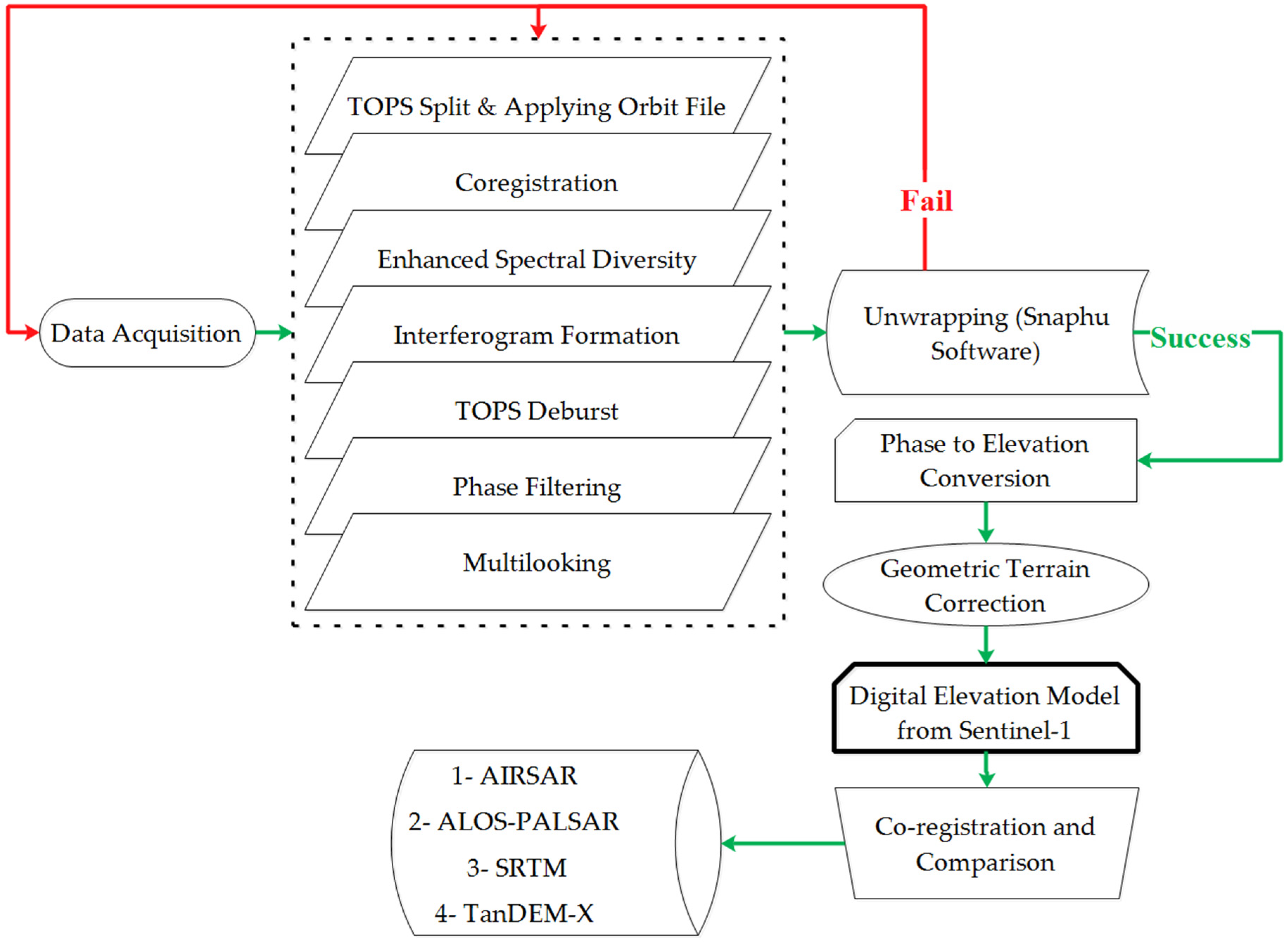
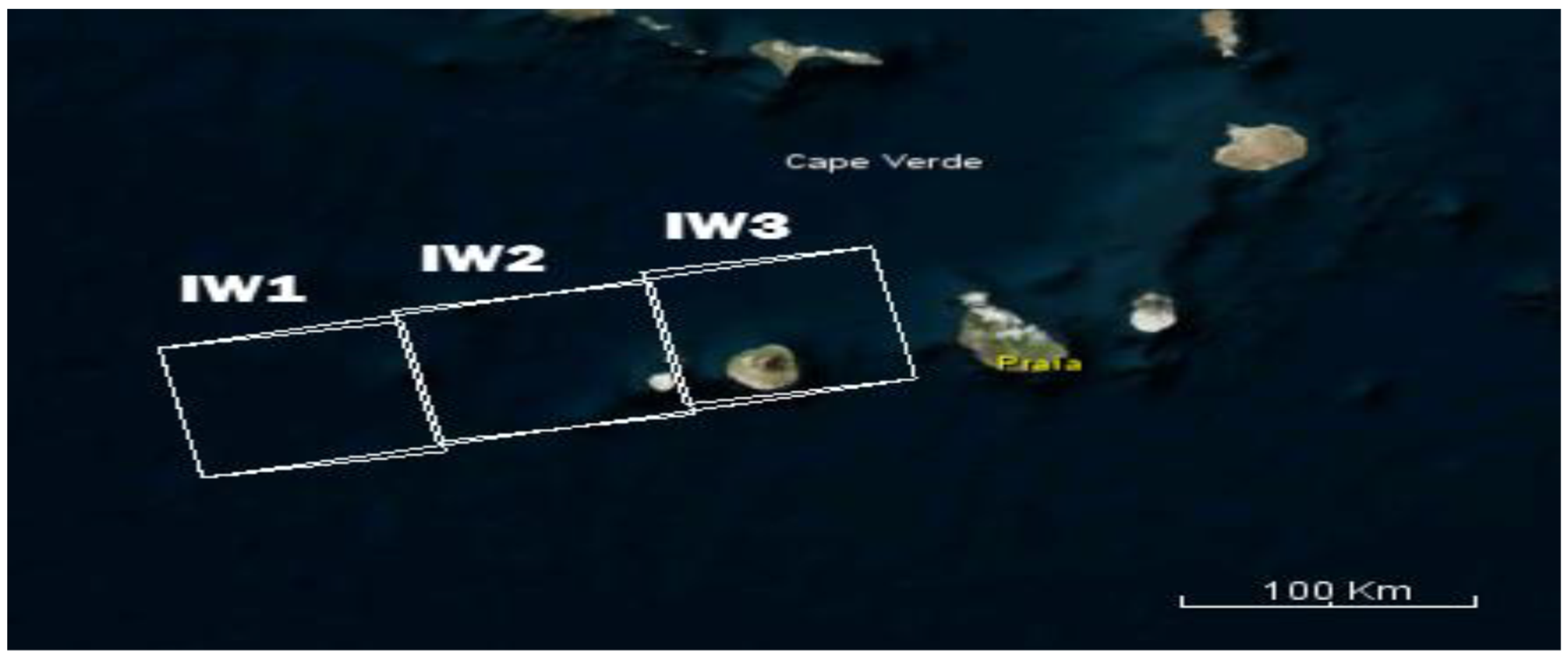


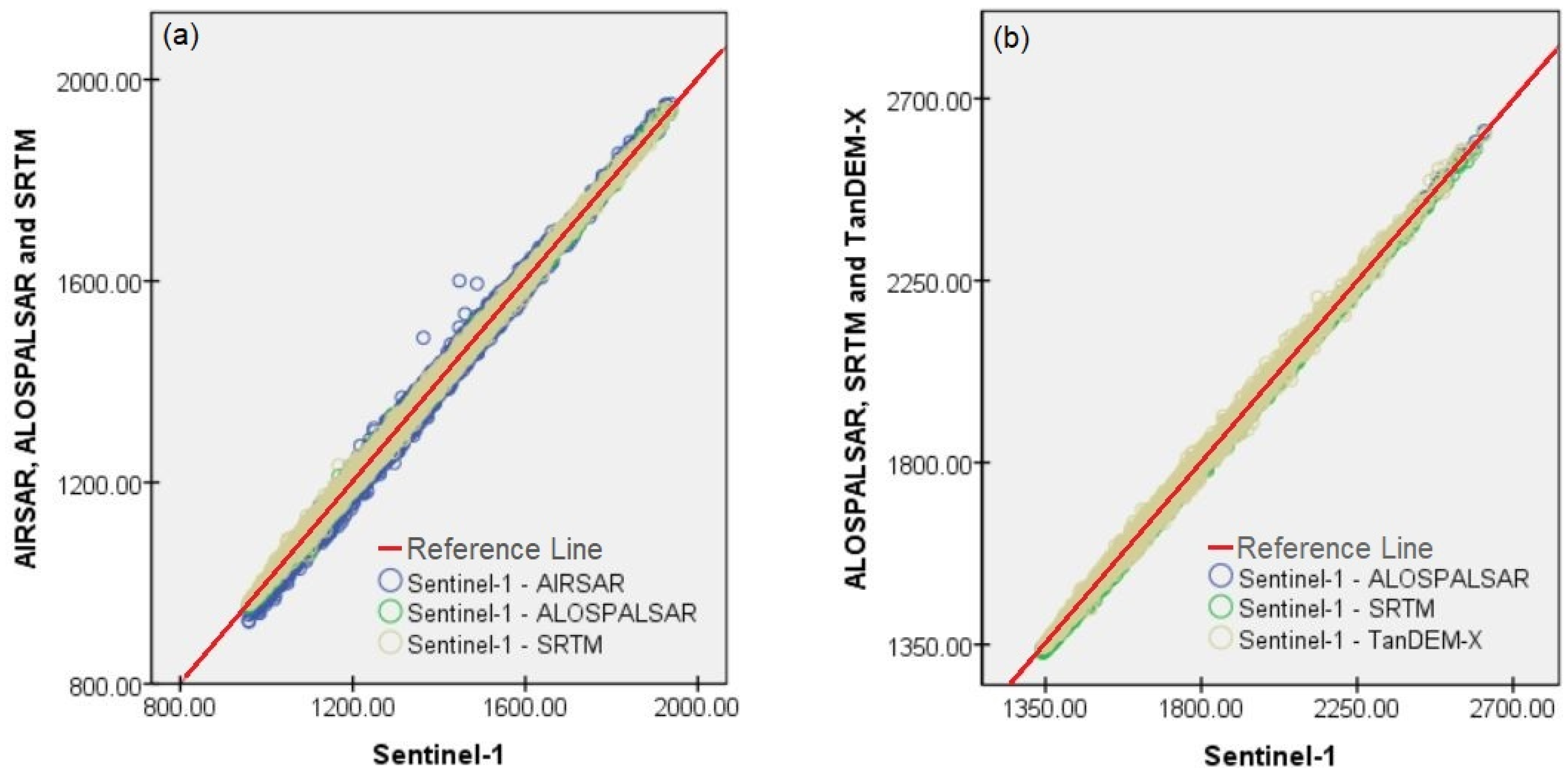



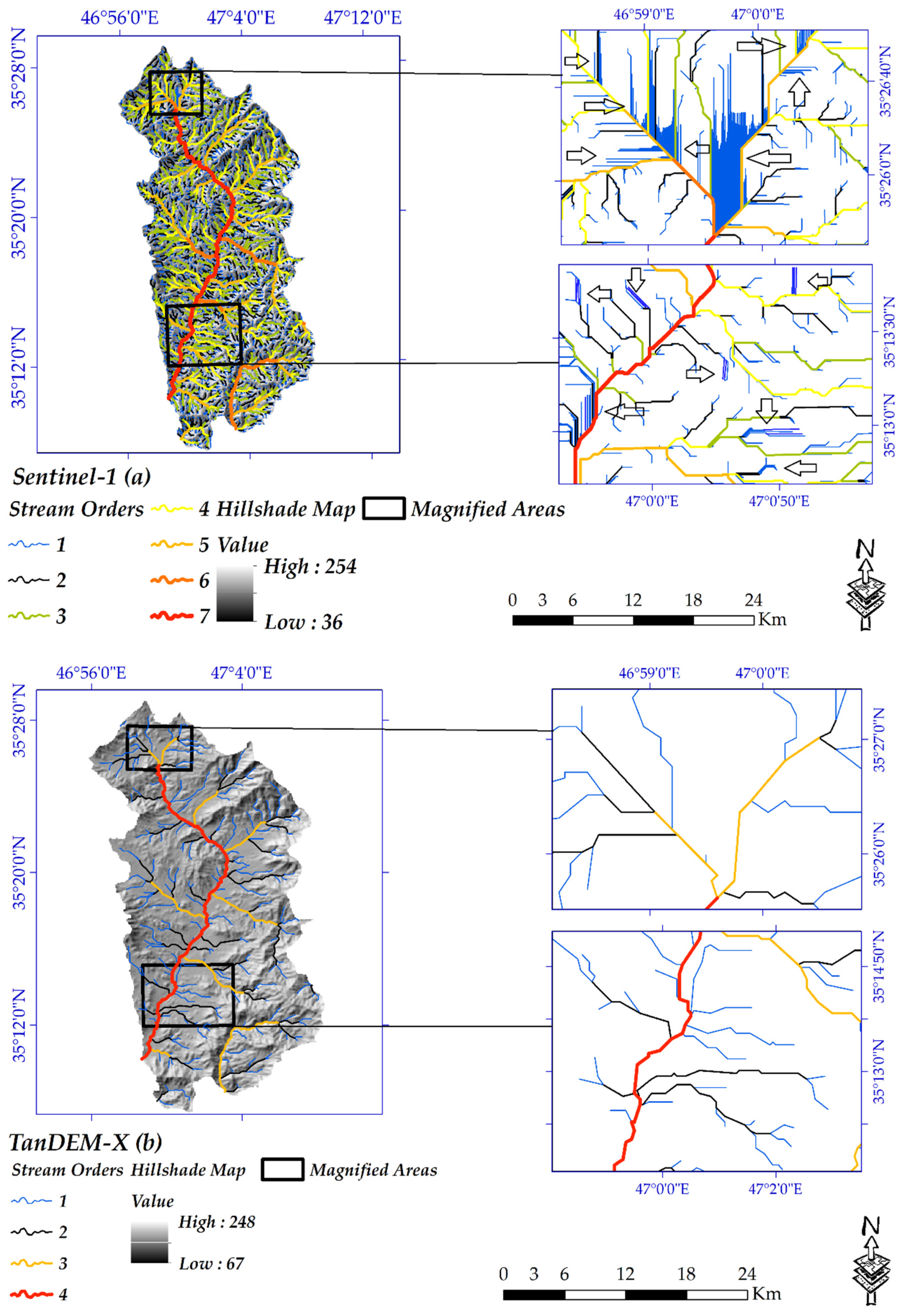
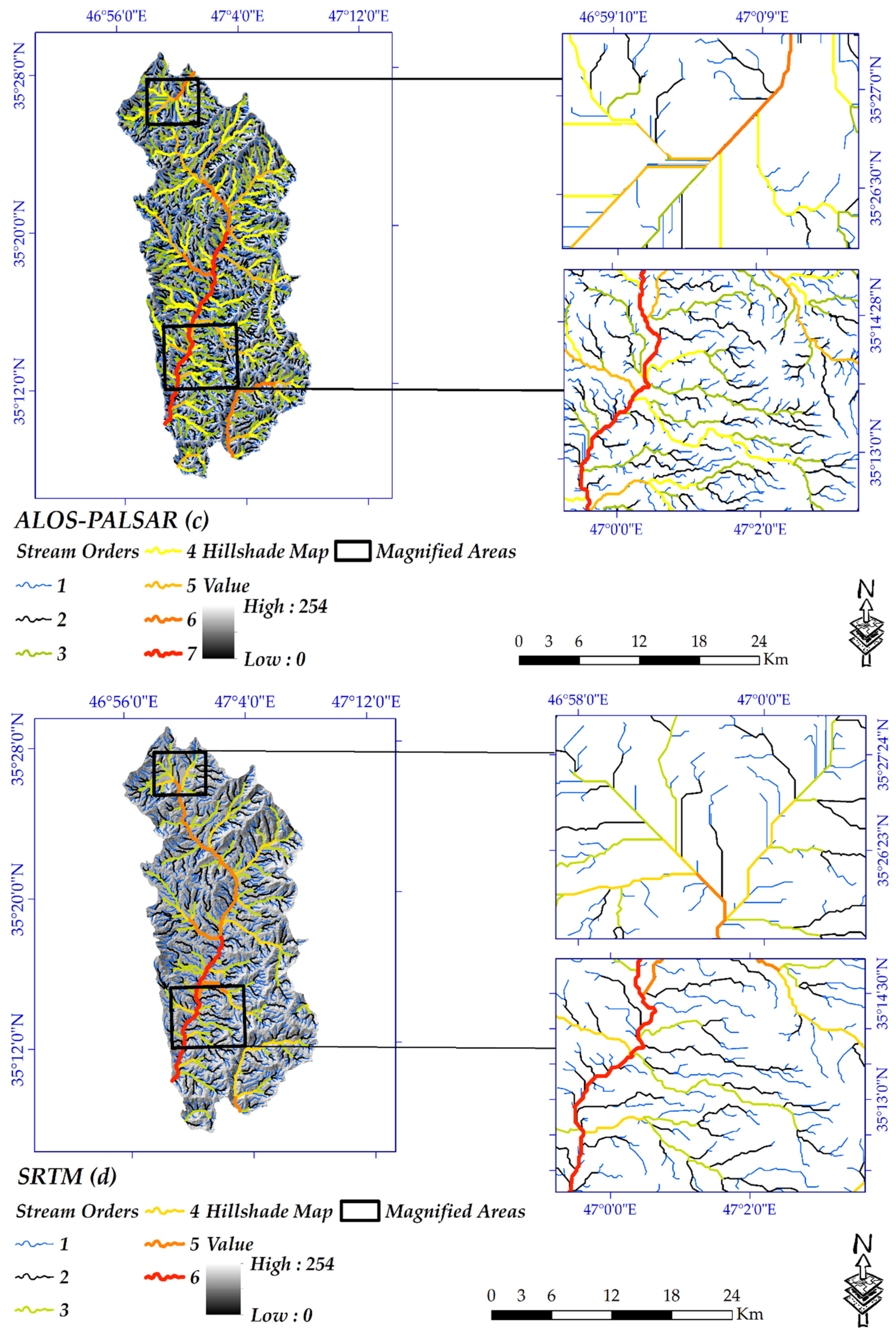
| Input Product | PB (m) | TB (day) | Sub-Swath | Polarization | Spatial Resolution (m) | |
|---|---|---|---|---|---|---|
| Malaysia | S1A_IW_SLC_20170220 S1A_IW_SLC_20170304 | 47 | 12 | IW1 | VV | 5 × 20 |
| Iran | S1B_IW_SLC_20200816 S1B_IW_SLC_20200723 | 109 | 25 | IW1 | VV | 5 × 20 |
| Statistical Parameters Study Area | R (%) | Std. Error of the Estimate (m) |
|---|---|---|
| Malaysia | 99 | 6.87 |
| Iran | 100 | 4.31 |
| No. | Study Area (Iran) | Study Area (Malaysia) | ||||
|---|---|---|---|---|---|---|
| DEMs | Minimum Outlier Value (m) | Maximum Outlier Value (m) | DEMs | Minimum Outlier Value (m) | Maximum Outlier Value (m) | |
| 1 | ALOSPALSAR | 3.15 | 5.95 | ALOSPALSAR | 2 | 9.8 |
| 2 | SRTM | –5.5 | 14.5 | SRTM | –5.5 | 22.5 |
| 3 | Sentinel-1 | –6.5 | 15.5 | Sentinel-1 | –6.2 | 13 |
| 4 | TanDEM-X | –13.3 | 36.4 | AIRSAR | –2.4 | 13.4 |
| UTM Coordinates and Elevation of GCPs1. | Corresponding Elevation of the DEMs | ||||||
|---|---|---|---|---|---|---|---|
| No. | X (m) | Y (m) | H (m) | ALOS (m) | SRTM (m) | Sentinel (m) | TanDEM-X (m) |
| 1 | 680,712 | 3,908,740 | 1544 | 1548 | 1540 | 1551 | 1541 |
| 2 | 682,441 | 3,904,790 | 1436 | 1441 | 1427 | 1439 | 1441 |
| 3 | 689,659 | 3,908,010 | 1598 | 1604 | 1591 | 1608 | 1612 |
| 4 | 678,987 | 3,923,820 | 1555 | 1551 | 1550 | 1561 | 1562 |
| 5 | 678,196 | 3,925,250 | 1588 | 1593 | 1586 | 1592 | 1606 |
| 6 | 682,564 | 3,890,380 | 1553 | 1558 | 1551 | 1549 | 1572 |
| RMSE (m) | ±5.2 | ±6.0 | ±6.7 | ±13.7 | |||
| 1 UTM = Universe Transverse Mercator Projection. | |||||||
| UTM Coordinates and Elevation of GCPs | Corresponding Elevation of the DEMs | ||||||
|---|---|---|---|---|---|---|---|
| No. | X (m) | Y (m) | H (m) | ALOS (m) | Sentinel (m) | SRTM (m) | AIRSAR (m) |
| 1 | 765,837 | 498,361 | 1611 | 1621 | 1622 | 1617 | 1615 |
| 2 | 763,839 | 496,053 | 1484 | 1489 | 1482 | 1479 | 1487 |
| 3 | 765,322 | 496,134 | 1554 | 1562 | 1562 | 1551 | 1561 |
| 4 | 764,306 | 496,469 | 1461 | 1466 | 1464 | 1466 | 1464 |
| 5 | 765,691 | 495,121 | 1546 | 1550 | 1559 | 1554 | 1554 |
| 6 | 768,850 | 493,748 | 1678 | 1682 | 1691 | 1688 | 1687 |
| 7 | 764,026 | 489,596 | 1190 | 1196 | 1196 | 1198 | 1186 |
| 8 | 768,510 | 488,383 | 1143 | 1149 | 1150 | 1148 | 1137 |
| RMSE (m) | ±6.8 | ±9.5 | ±7.1 | ±6.4 | |||
| GCP No. | Land Cover | Malaysia | GCP No. | Land Cover | Iran |
|---|---|---|---|---|---|
| RMSE (m) | RMSE (m) | ||||
| 2 | Vegetation and florification | 5.6 | 1 | Rangeland | 3.5 |
| 4 | 5 | ||||
| 8 | 6 | ||||
| 1 | Forest | 11.4 | 4 | Dryfarming | 5.0 |
| 3 | 3 | Agriculture | 7.0 | ||
| 5 | |||||
| 7 | |||||
| 6 | Township | 13.0 | 2 | Township | 9.0 |
Publisher’s Note: MDPI stays neutral with regard to jurisdictional claims in published maps and institutional affiliations. |
© 2020 by the authors. Licensee MDPI, Basel, Switzerland. This article is an open access article distributed under the terms and conditions of the Creative Commons Attribution (CC BY) license (http://creativecommons.org/licenses/by/4.0/).
Share and Cite
Mohammadi, A.; Karimzadeh, S.; Jalal, S.J.; Kamran, K.V.; Shahabi, H.; Homayouni, S.; Al-Ansari, N. A Multi-Sensor Comparative Analysis on the Suitability of Generated DEM from Sentinel-1 SAR Interferometry Using Statistical and Hydrological Models. Sensors 2020, 20, 7214. https://doi.org/10.3390/s20247214
Mohammadi A, Karimzadeh S, Jalal SJ, Kamran KV, Shahabi H, Homayouni S, Al-Ansari N. A Multi-Sensor Comparative Analysis on the Suitability of Generated DEM from Sentinel-1 SAR Interferometry Using Statistical and Hydrological Models. Sensors. 2020; 20(24):7214. https://doi.org/10.3390/s20247214
Chicago/Turabian StyleMohammadi, Ayub, Sadra Karimzadeh, Shazad Jamal Jalal, Khalil Valizadeh Kamran, Himan Shahabi, Saeid Homayouni, and Nadhir Al-Ansari. 2020. "A Multi-Sensor Comparative Analysis on the Suitability of Generated DEM from Sentinel-1 SAR Interferometry Using Statistical and Hydrological Models" Sensors 20, no. 24: 7214. https://doi.org/10.3390/s20247214
APA StyleMohammadi, A., Karimzadeh, S., Jalal, S. J., Kamran, K. V., Shahabi, H., Homayouni, S., & Al-Ansari, N. (2020). A Multi-Sensor Comparative Analysis on the Suitability of Generated DEM from Sentinel-1 SAR Interferometry Using Statistical and Hydrological Models. Sensors, 20(24), 7214. https://doi.org/10.3390/s20247214










